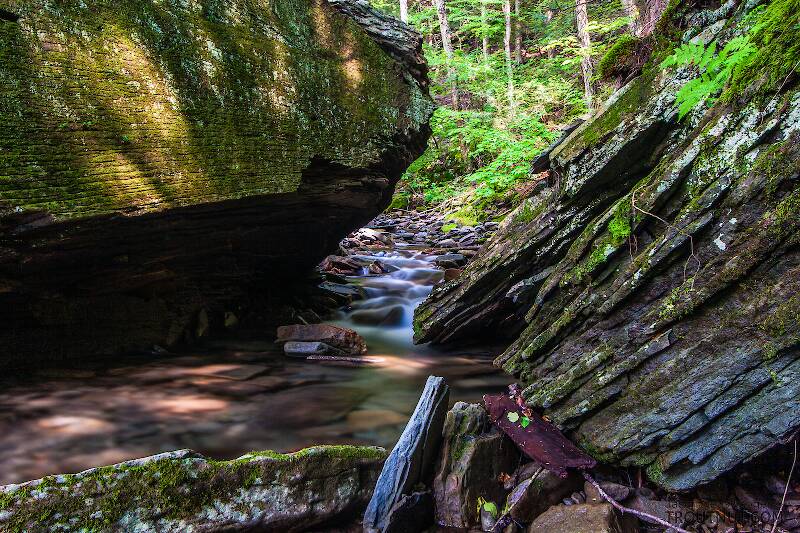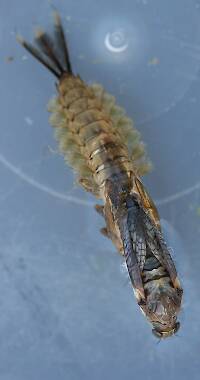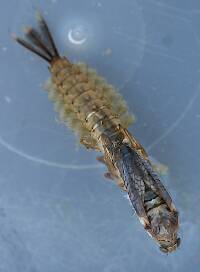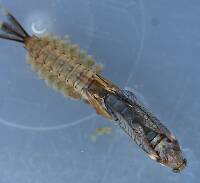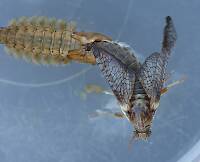
Salmonflies
Pteronarcys californica
The giant Salmonflies of the Western mountains are legendary for their proclivity to elicit consistent dry-fly action and ferocious strikes.
Featured on the forum

As far as I can tell, this species has only previously been reported from one site in Oregon along the Columbia gorge. However, the key characteristics are fairly unmistakable in all except for one minor detail:
— 4 small yellow spots on frons visible in photos
— Narrow occipital spinule row curves forward (but doesn’t quite meet on stem of ecdysial suture, as it's supposed to in this species)
— Short spinules on anterior margin of front legs
— Short rposterior row of blunt spinules on abdominal tergae, rather than elongated spinules dorsally
I caught several of these mature nymphs in the fishless, tiny headwaters of a creek high in the Wenatchee Mountains.
— 4 small yellow spots on frons visible in photos
— Narrow occipital spinule row curves forward (but doesn’t quite meet on stem of ecdysial suture, as it's supposed to in this species)
— Short spinules on anterior margin of front legs
— Short rposterior row of blunt spinules on abdominal tergae, rather than elongated spinules dorsally
I caught several of these mature nymphs in the fishless, tiny headwaters of a creek high in the Wenatchee Mountains.

Troutnut is a project started in 2003 by salmonid ecologist Jason "Troutnut" Neuswanger to help anglers and
fly tyers unabashedly embrace the entomological side of the sport. Learn more about Troutnut or
support the project for an enhanced experience here.
Fishingguru on Jan 31, 2008January 31st, 2008, 3:39 pm EST
Has anyone fished twisted hackle emergers and how did they fare? I saw an article some time back and it sounded interesting. Twist the hackle with the dubbing used for the thorax. Seems like it would give a nice splay for legs.
Lav
Lonehunter on Feb 8, 2008February 8th, 2008, 5:32 am EST
Hi
Never have.. I would love to see a picture on one done correctly.
Love to steel others ideas LOL
Thanks
Never have.. I would love to see a picture on one done correctly.
Love to steel others ideas LOL
Thanks
TIGHT LINES
PRACTICE CATCH AND RELEASE
JACK
ENJOY THE JOURNEY NOT THE FINISH
PRACTICE CATCH AND RELEASE
JACK
ENJOY THE JOURNEY NOT THE FINISH
Martinlf on Feb 8, 2008February 8th, 2008, 3:01 pm EST
I tried to look this one up and learned it's a Shane Stalcup pattern. Does anyone have directions for it, or for another favorite emerger?
I've mentioned the Little Lehigh Flyshop BWO CDC emerger a few times, which gave me a spectacular day once, and I recently had a buddy send me a Pat Dorsey BWO emerger that I'm using as a model for a new fly that combines the winging method on the Compoly Dun (A Google search will take you to a recipe) with Lloyd Gonzales method of tying an emerger shuck, except I'm trying CDC on some instead of synthetics, and cutting the wing short after slanting it back. I may add a wrap or two of hackle on some too. I also think a parachute with shorter hackles and a shuck makes a superb emerger. What are some other favorite patterns out there?
I've mentioned the Little Lehigh Flyshop BWO CDC emerger a few times, which gave me a spectacular day once, and I recently had a buddy send me a Pat Dorsey BWO emerger that I'm using as a model for a new fly that combines the winging method on the Compoly Dun (A Google search will take you to a recipe) with Lloyd Gonzales method of tying an emerger shuck, except I'm trying CDC on some instead of synthetics, and cutting the wing short after slanting it back. I may add a wrap or two of hackle on some too. I also think a parachute with shorter hackles and a shuck makes a superb emerger. What are some other favorite patterns out there?
"He spread them a yard and a half. 'And every one that got away is this big.'"
--Fred Chappell
--Fred Chappell
Dano on Feb 8, 2008February 8th, 2008, 5:32 pm EST
Can't say that I've tried this twisted hackle technique...Seems to me, though, that it would be worth a shot on nymphs rather than emegers. Most I've seen have a beard style soft hackle. Which, IMSHO, would be a more realistic impression of the legs...
In answer to Louis' last question: My favorite emerger pattern is the one they're biting on. Not trying to be a smartass, really. My "emergers" are the traditional wets that I carry. But, when things are going fast and furious during a hatch caught with a dry on the end of my tippet and all I'm gettin' are bulges with no hits, I simply nip back the wings and hackles, put a dab of mud on the fly, then get back to business.
However, back in the early 80s when these things were just becoming the rage and I got the Supplement II for my Index of Orvis Fly Patterns, I used this pattern:

Note that Orvis forgot to include the beard style hackle (Wood Duck) in the recipe.
After a couple of seasons in not seeing any difference in my catch ratios, I stopped using 'em. FWIW.
Dano
In answer to Louis' last question: My favorite emerger pattern is the one they're biting on. Not trying to be a smartass, really. My "emergers" are the traditional wets that I carry. But, when things are going fast and furious during a hatch caught with a dry on the end of my tippet and all I'm gettin' are bulges with no hits, I simply nip back the wings and hackles, put a dab of mud on the fly, then get back to business.
However, back in the early 80s when these things were just becoming the rage and I got the Supplement II for my Index of Orvis Fly Patterns, I used this pattern:

Note that Orvis forgot to include the beard style hackle (Wood Duck) in the recipe.
After a couple of seasons in not seeing any difference in my catch ratios, I stopped using 'em. FWIW.
Dano
Quick Reply
Related Discussions
Topic
Replies
Last Reply
14
Apr 18, 2011
by Troutnut
by Troutnut

